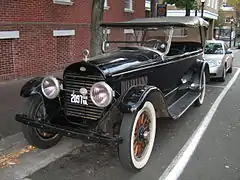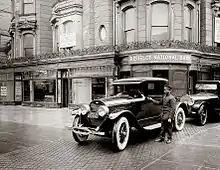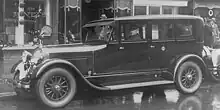Lincoln L series
The Lincoln L series (also called the Lincoln Model L) is the first automobile that was produced by the Lincoln Motor Company.[1] Introduced in 1920, the L series would continue to be produced after the bankruptcy of Lincoln in 1922 and its purchase by Ford Motor Company.
| Lincoln L series | |
|---|---|
 1929 Lincoln L-series Sport Touring | |
| Overview | |
| Manufacturer | Lincoln Motor Company Lincoln (Ford) |
| Also called | Lincoln Model L |
| Production | 1920–1930 |
| Assembly | United States: Detroit, Michigan (Lincoln Motor Company Plant) |
| Designer | Angus Woodbridge Edsel Ford |
| Body and chassis | |
| Class | Luxury car |
| Body style | 2-door convertible 4-door convertible 2-door coupe 4-door sedan 4-door town car 4-door limousine 4-door phaeton |
| Layout | FR layout |
| Powertrain | |
| Engine |
|
| Transmission | 3-speed manual |
| Dimensions | |
| Wheelbase |
|
| Chronology | |
| Successor | Lincoln K series/Model K |
It was an alternative to various top level luxury vehicles to include the Mercedes-Benz 630, Rolls-Royce Phantom I, Renault Type MC, Packard Twin Six, and Cadillac Type 61. It was replaced during 1930 by the Model K.
Model history
1917–1922

After leaving the company over a dispute with William Durant over World War I production, Cadillac founder Henry Leland created the Lincoln Motor Company. Initially, the company produced Liberty V12 aircraft engines as its only source of revenue. With the war concluded, and at the age of 74, Leland decided to make the Lincoln Motor car. The company was reorganized in 1920 and created the first L-series car in 1920, for sale as a 1921 model.[1]
The L series was designed by Angus Woodbridge, the son-in-law of Henry Leland; trained as a ladies hatmaker, the design of the L series was considered old-fashioned for the time.[1] The company catered early on to providing custom coachwork for its clients, and both Brunn and Judkins offered two choices each. 15 selections were available from Lincoln coachbuilders; roadsters, coupes, touring sedans, phaetons, and broughams, with a Town Car offered at US$6,600 ($108,284 in 2022 dollars [2]).[1] Brunn offered both a roadster and a phaeton, while Judkins offered both a sedan and a berline with glass partitions.[1] To further accommodate the particular client, the chassis was sold for US$4,000 ($65,627 in 2022 dollars [2]).[1]
After World War I, the Lincoln Motor Company struggled in the postwar recession with repeated, false tax evasion claims.[3] Total calendar year production for 1920 and 1921 were quoted to be 2,957.[1]
| Year | Engine | HP | Transmission | Wheelbase | Tire size |
|---|---|---|---|---|---|
| 1921 | 357.8 cu in (5.9 L) 60° L-head V8 | 81[1] | 3-speed manual | 130 in (3,302 mm) [1] | 23" |
1922–1923

In financial trouble, Leland sold the company to Henry Ford February 4, 1922 for $8 million ($139,864,811 in 2022 dollars [2]), the amount determined by the judge presiding over the receivership Arthur J. Tuttle.[4][1] Henry Leland valued the company at over $16 million. After a few months the Lelands left the company because of Henry Ford's managerial style and his son, Edsel Ford, designed a new body for the L series. Edsel became president and Ernest C. Kanzler general manager. The L series was a robust car. In the first year, hydraulic shock absorbers were added.[1] Edsel and Kanzler implemented production economies, trimming manufacturing costs by about $1000 per car.
Aside from the extension of the wheelbase from 130 to 136 inches, the chassis of the Lincoln Model L saw few major changes; the 60-degree L-head V8 remained in production. The V8 used a novel approach for the piston connecting rods called Fork and Blade, which meant two connecting rods shared one bearing on the crankshaft, which allowed for a short crankshaft and a smaller overall engine size, while still displacing 357.8 cu in (5.9 L). The cylinders in both banks are also not offset from each other.
For 1923, several new body styles were introduced for the Model L under the direction of Edsel, including two and three-window four-door sedans, and a four-passenger phaeton. Other vehicles included a two-passenger roadster, and a $5,200 ($89,314 in 2022 dollars [2]) seven-passenger touring sedan and limousine. A sedan, limousine, cabriolet, and town car were also offered by coachbuilders LeBaron, Fleetwood, Judkins, Derham, Holbrook, Willoughby and Dietrich, and a second cabriolet was offered by coachbuilder Brunn. Vehicles built by these coachbuilders went for as much as $7,200; despite the relatively niche market segment, Lincoln sales rose about 45 percent to produce 7,875 cars and the company was operating at a profit by the end of 1923.
| Year | Engine | HP | Transmission | Wheelbase | tire size |
|---|---|---|---|---|---|
| 1923 | 357.8 cu in (5.9 L) | 90 | 3-speed manual | 136 in (3,454 mm) [1] | 23" |
1924–1926
In 1924, the L series was given a newer look with such things as a nickel-plated radiator shell, while 1925 is identified by the absence of cowl lights. Front and rear bumpers became standard. The smallest L series was the 2-door, 2-passenger roadster. 1926 was basically the same except for some interior changes.[1]
In 1924 large touring sedans began to be used by police departments around the country. They were known as Police Flyers, which were equipped with four-wheel brakes, two years before they were introduced on private-sale vehicles. These specially equipped vehicles, with bulletproof windshields measuring 7/8 of an inch thick and spot lights mounted on the ends of the windshield, also came with an automatic windshield wiper for the driver and a hand-operated wiper for the front passenger. Police whistles were coupled to the exhaust system and gun racks were also fitted to these vehicles.
| Year | Engine | HP | Transmission | Wheelbase | tire size |
|---|---|---|---|---|---|
| 1925 | 357.8 cu in (5.9 L) V8 | 90 | 3-speed manual[1] | 136 in (3,454 mm) | 23" |
1927–1930

In 1927, the L series got smaller wheels with 4-wheel standard mechanical brakes.[1] All instruments were on an oval surface. A larger engine (though no HP increase) came in 1928. 1929 brought Safety glass and dual windshield wipers. 1930 was the last year for the L series.
| Year | Engine | HP | Transmission | Wheelbase | tire size |
|---|---|---|---|---|---|
| 1928 | 384.8 cu in (6.3 L) V8 | 90 | 3-speed manual | 136 in (3,454 mm) | 20"[1] |
Coachbuilt examples
Lincoln contracted with dozens of coachbuilders during the 1920s and early 30s to create multiple custom built vehicles, to include American, Anderson, Babcock, Holbrook, Judkins, Lang, LeBaron, Locke, Murray, Towson, and Willoughby in the 1920s. Murphy, Rollston, and Waterhouse were added in the 1930s.[1] Optional equipment was not necessarily an issue with 1920s Lincolns; special and bespoke items were accommodated on customer vehicles. A nickel-plated radiator shell could be installed for $25, varnished natural wood wheels were $15, or Rudge-Whitworth center-lock wire wheels for another $100. Disteel steel disc wheels were also available for $60.
Lincoln chose not to make yearly model changes, used as a marketing tool of the time, designed to lure new customers. Lincoln customers of the time were known to purchase more than one Lincoln with different bodywork, so changing the vehicle yearly was not done to accommodate their customer base.[5]: 52–57
Pop culture
A 1924 Lincoln was featured in the first season of the classic CBS sitcom The Good Guys.
In the 1986 comedy movie, The Money Pit, the house came with a 1929-30 Lincoln L-series 4-door Sport Phaeton as a part of the purchase.
A blue 1928 Lincoln L can be seen in the bridge scene in the movie The Untouchables.
References
- Kimes, Beverly (1996). Standard Catalog of American Cars 1805–1942. Krause Publications. pp. 867–886. ISBN 0-87341-428-4.
- 1634–1699: McCusker, J. J. (1997). How Much Is That in Real Money? A Historical Price Index for Use as a Deflator of Money Values in the Economy of the United States: Addenda et Corrigenda (PDF). American Antiquarian Society. 1700–1799: McCusker, J. J. (1992). How Much Is That in Real Money? A Historical Price Index for Use as a Deflator of Money Values in the Economy of the United States (PDF). American Antiquarian Society. 1800–present: Federal Reserve Bank of Minneapolis. "Consumer Price Index (estimate) 1800–". Retrieved May 28, 2023.
- Mandel, Leon (1982). American Cars. Stewart, Tabori & Chang, Inc. ISBN 0-941434-19-2.
- Weiss, H. Eugene (2003). Chrysler, Ford, Durant, and Sloan. McFarland. ISBN 0-7864-1611-4.
- Bentley, John (1952). The Old Car Book. Vol. 208.